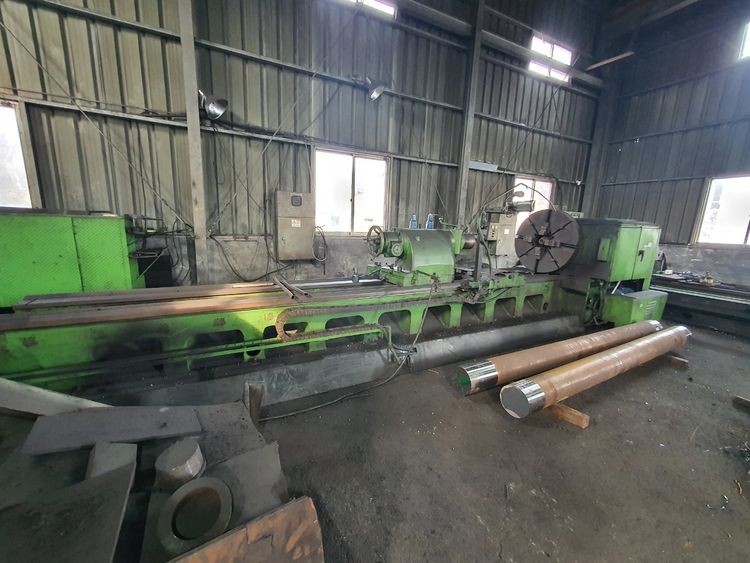Russian Lathe Incident: The Untold Story That Shook The World
Imagine this: a quiet corner of the manufacturing world suddenly becomes the epicenter of global attention. The Russian Lathe Incident isn't just a tale of engineering gone wrong—it's a saga that connects politics, technology, and human error in ways no one could have predicted. This incident, which has sent ripples through industries worldwide, has become a hot topic for engineers, policymakers, and enthusiasts alike. In this article, we'll dive deep into the nitty-gritty details, uncovering the truth behind the headlines.
Now, why should you care? Well, the Russian Lathe Incident isn't just a blip on the radar—it's a wake-up call for industries relying heavily on precision machinery. From manufacturing plants to aerospace companies, this event highlights vulnerabilities that could affect us all. We're talking about the intersection of technology, geopolitics, and industrial safety. Stick around, because this story is about to get wild.
Before we jump into the juicy details, let me assure you that this isn't just another boring article. We'll break down complex concepts into bite-sized chunks, throw in some fun facts, and maybe even a few surprises along the way. So, buckle up, because we're about to explore the world of lathes, politics, and everything in between.
Read also:Joseph Bartolozzi The Man Who Changed The World Of Flute Playing
What Exactly Is the Russian Lathe Incident?
Let's start with the basics. The Russian Lathe Incident refers to a controversial event involving a high-precision lathe machine manufactured in Russia. In layman's terms, a lathe is a machine used to shape metal or wood by rotating it against a cutting tool. Sounds simple, right? But this particular lathe was no ordinary piece of equipment. It was state-of-the-art, designed for critical applications in defense and aerospace.
Here's the kicker: the lathe in question was allegedly sold to a foreign entity without proper authorization. This breach of export regulations sparked a diplomatic firestorm, with accusations flying left and right. The incident raised questions about international trade laws, industrial espionage, and the security of sensitive technologies. And trust me, the story gets more twisted as we dig deeper.
Why Should You Care About Lathes?
You might be thinking, "Why should I care about a machine I've never even seen?" Well, my friend, lathes are the unsung heroes of modern manufacturing. They're the backbone of industries producing everything from car parts to medical devices. Without them, our world would look a lot different.
The Russian Lathe Incident sheds light on the importance of safeguarding critical technologies. It's not just about protecting machines—it's about ensuring the security of entire industries. In today's interconnected world, a single breach can have far-reaching consequences. So, whether you're an engineer, a policymaker, or just a curious reader, this story has something for everyone.
A Brief History of Lathes
Before we dive into the incident itself, let's take a quick trip down memory lane. Lathes have been around for thousands of years, with early versions used by ancient Egyptians and Greeks. Fast forward to the Industrial Revolution, and lathes became indispensable tools in factories worldwide.
Today, modern lathes are marvels of engineering, capable of achieving incredible levels of precision. They're used in everything from car manufacturing to spacecraft production. The Russian lathe at the center of this incident is part of this lineage, representing the cutting edge of technological advancement.
Read also:Movierulz Com 2023 Your Ultimate Guide To Streaming Movies
Key Features of Modern Lathes
- High Precision: Capable of tolerances as small as a few microns.
- Automation: Many modern lathes are fully automated, reducing human error.
- Material Versatility: Can work with a wide range of materials, from metals to plastics.
The Role of Technology in the Incident
Technology played a pivotal role in the Russian Lathe Incident. The lathe in question was equipped with advanced software and sensors, allowing it to perform tasks with unmatched accuracy. However, this same technology also made it vulnerable to hacking and unauthorized use.
Experts believe that the breach occurred through a combination of human error and cybersecurity lapses. This highlights the need for robust security measures in the manufacturing sector. As technology continues to evolve, so too must our approaches to safeguarding it.
Lessons Learned from the Incident
- Strengthen Export Controls: Governments must ensure that sensitive technologies are not exported without proper authorization.
- Improve Cybersecurity: Manufacturers need to invest in advanced cybersecurity measures to protect their equipment.
- Enhance Training: Employees should be trained to recognize and respond to potential security threats.
Political Implications of the Incident
The Russian Lathe Incident didn't just shake the manufacturing world—it also sent shockwaves through the political arena. Diplomatic relations between Russia and several countries were strained as accusations of espionage and illegal trade practices were thrown around.
Some experts argue that the incident is part of a larger geopolitical struggle for technological dominance. Others see it as a wake-up call for nations to reevaluate their trade policies and security measures. Whatever the case may be, one thing is clear: the world is paying attention.
International Trade Laws
International trade laws play a crucial role in regulating the export of sensitive technologies. The Russian Lathe Incident has sparked debates about the effectiveness of these laws and whether they need to be updated to reflect modern challenges.
Here are some key points to consider:
- Current laws may not be sufficient to address the complexities of modern technology.
- There is a growing need for international cooperation to combat illegal trade practices.
- Transparency and accountability are essential for maintaining trust in global trade.
Impact on the Manufacturing Industry
The Russian Lathe Incident has had a profound impact on the manufacturing industry. Companies are now more vigilant about the security of their equipment and the integrity of their supply chains. This has led to increased investment in cybersecurity and quality control measures.
On the flip side, the incident has also raised concerns about the accessibility of advanced technologies. Some argue that overly restrictive regulations could stifle innovation and hinder economic growth. Finding the right balance is a challenge that industries and governments must tackle together.
Innovation vs. Security
The debate between innovation and security is at the heart of the Russian Lathe Incident. While it's essential to protect sensitive technologies, we must also ensure that they remain accessible to those who need them. Striking this balance requires collaboration between industry leaders, policymakers, and technologists.
Human Error: The Weakest Link
Let's not forget the human factor in all of this. Despite the advanced technology involved, human error remains one of the biggest vulnerabilities in any system. Whether it's a lapse in judgment, a failure to follow protocols, or a simple mistake, human error can have far-reaching consequences.
Experts recommend implementing comprehensive training programs and fostering a culture of accountability to minimize the risk of human error. After all, even the most advanced technology is only as good as the people using it.
Looking Ahead: What's Next?
As we look to the future, it's clear that the lessons learned from the Russian Lathe Incident will shape the way we approach technology, security, and international trade. Industries will continue to innovate, but they must do so with a keen awareness of the risks involved.
So, what can you do? Stay informed, ask questions, and be part of the conversation. Whether you're an engineer, a policymaker, or just a curious reader, your voice matters. Together, we can ensure that incidents like this become a thing of the past.
Call to Action
Now it's your turn to join the discussion. Leave a comment below and share your thoughts on the Russian Lathe Incident. What do you think about the balance between innovation and security? How can we ensure that sensitive technologies are used responsibly? Your input could help shape the future of this important conversation.
Conclusion
The Russian Lathe Incident is more than just a story about a machine—it's a reflection of the complexities of our modern world. From technology and politics to human error and cybersecurity, this event touches on issues that affect us all. By understanding the lessons learned from this incident, we can work towards a safer, more secure future.
So, what are you waiting for? Dive deeper into the world of lathes, technology, and geopolitics. Share this article with your friends and colleagues, and let's keep the conversation going. Because in the end, it's all about learning, growing, and making the world a better place—one lathe at a time.
Table of Contents
- What Exactly Is the Russian Lathe Incident?
- Why Should You Care About Lathes?
- A Brief History of Lathes
- The Role of Technology in the Incident
- Political Implications of the Incident
- Impact on the Manufacturing Industry
- Human Error: The Weakest Link
- Looking Ahead: What's Next?
- Call to Action
- Conclusion



